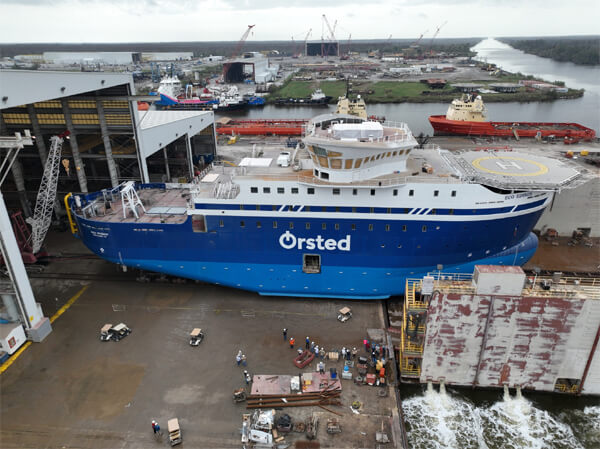Maersk Supply Service and Edison Chouest Partner for Wind Feeder Vessels

The U.S. shipbuilding industry continues to benefit from the emergence of the offshore wind energy sector. The latest deal is a partnership between Maersk Supply Service and Louisiana-based Edison Chouest Offshore for the construction of vessels as part of Maersk’s feeder ship approach that is designed to enable faster offshore wind installations.
The partnership is the next step in the implementation of the company’s feeder spread. It will include two tugs and two barges to be built by Bollinger Shipyards. They will be owned and operated by ECO in support of the installation system.
Maersk Supply Service detailed its plans for the feeder approach several years ago and already has its large wind turbine installation vessel on order with Seatrium in Singapore (former Sembcorp Marine) and it is expected to be delivered in 2025. The concept is that the massive jack-up vessel, which will be registered in Denmark, will be positioned at the site, and be fed by specialized barges transporting materials from the staging area at the wind port with the tugs.
“Maersk Supply Service’s new installation concept can make offshore wind farm installations significantly faster with estimated efficiency gains of 30 percent. The partnership with ECO makes this new technology available for the U.S. offshore wind market enabling faster offshore wind installations in the U.S.,” said Christian M. Ingerslev, CEO of Maersk Supply Service.

In a separate wind sector project, ECO is building the first U.S.-flagged SOV for the offshore wind (Orsted)
The barges and tugs will be registered in the U.S. to meet Jones Act requirements. The WTIV will have a unique interlocking system that will secure the barges and raise trays with the components feeding the installation process. According to Maersk, in addition to meeting the Jones Act requirements, the WTIV spends more time on site and the locking and stabilizing system is less dependent on weather and sea conditions for the supply operation.
Maersk Supply Service already has the installation contract for the Empire Wind 1 project, which is now being developed by Equinor. It has cleared most of its hurdles, including the decision to split the partnership between Equinor and BP. Equinor expects to make the final investment decision by mid-2024 on the wind farm, which has already received its federal approvals from BOEM and just recently cleared to renegotiate its power contract by New York State. The second phase, Empire Wind II, however, has been put on hold and Maersk also has a contract for Beacon Wind which now belongs to BP.
The first installation is to be from the South Brooklyn Marine Terminal which will be the staging area. The barges are less likely to have height and clearance problems while they are moving materials to the offshore location.
ECO has already entered the offshore wind sector and is looking to expand its opportunities in the industry. In December 2023, ECO moved the first U.S.-built Service Operation Vessel, ECO Edison, from the building dock. The ship is set to operate to support Ørsted’s offshore operations.
Last year, President Joe Biden highlighted that companies have already announced 18 offshore wind shipbuilding projects. This includes investments of nearly $3.5 billion across 12 manufacturing facilities and 13 ports to strengthen the American offshore wind supply chain.
